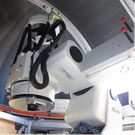Observatories
This post is also available in: Japanese
Haleakala Observatory, Hawaii
| Haleakala Observatory | Haleakala summit, Maui, Hawaii 20deg 42.5′ NLat., 203deg 44.5′ ELon., Alt 3040m |
| Member | Director: Kagitani |
| Instruments and Data |
For research |
 The Hawaii Haleakala Observatory is located at the summit of Haleakala Mountain (3,040 m above sea level) on the island of Maui, part of the University of Hawaii/Haleakala Observatory complex. Under an agreement between Tohoku University and the University of Hawaii’s Institute for Astronomy (IfA), the T40 telescope (a 40 cm aperture Schmidt-Cassegrain telescope Meade LX200GPS-16 in its own 2.6 m observation dome and German-style equatorial mount ERDE E-400 ) and the T60 telescope (a 60 cm aperture Cassegrain-Coude reflecting telescope made by Mitaka) were installed in March 2006 and September 2014, respectively. The summit of Haleakala has excellent year-round clear sky and seeing conditions, making it one of the world’s most favourable observing sites for astronomical observations. Both the T60 and T40 telescopes can be remotely observed via an Internet connection. The telescopes are equipped with spectrographs and are continuously used for infrared observations of the temperature and velocity fields of the Venusian and Martian atmospheres, optical observations of the sodium and sulphur gases emanating from Jupiter’s moon Io, and observations of Mercury’s sodium rarefied atmosphere. It also accepts collaborations with external researchers, including those who bring their own instruments.
The Hawaii Haleakala Observatory is located at the summit of Haleakala Mountain (3,040 m above sea level) on the island of Maui, part of the University of Hawaii/Haleakala Observatory complex. Under an agreement between Tohoku University and the University of Hawaii’s Institute for Astronomy (IfA), the T40 telescope (a 40 cm aperture Schmidt-Cassegrain telescope Meade LX200GPS-16 in its own 2.6 m observation dome and German-style equatorial mount ERDE E-400 ) and the T60 telescope (a 60 cm aperture Cassegrain-Coude reflecting telescope made by Mitaka) were installed in March 2006 and September 2014, respectively. The summit of Haleakala has excellent year-round clear sky and seeing conditions, making it one of the world’s most favourable observing sites for astronomical observations. Both the T60 and T40 telescopes can be remotely observed via an Internet connection. The telescopes are equipped with spectrographs and are continuously used for infrared observations of the temperature and velocity fields of the Venusian and Martian atmospheres, optical observations of the sodium and sulphur gases emanating from Jupiter’s moon Io, and observations of Mercury’s sodium rarefied atmosphere. It also accepts collaborations with external researchers, including those who bring their own instruments.
Iitate Observatory
| Iitate Observatory | Maeda, Iitate, Soma-gun, Fukushima 37deg. 42′ NLat., 140deg 40′ ELon., Alt. 600m |
| Member | Director: Misawa, Vice-director: Kumamoto |
| Instruments and Data | For research |
 The Iitate observatory consists of two stations: the Jupiter Galaxy Radio Observatory, established in 1992 to observe natural radio waves in the decametre wave band with wavelengths of about 10 meters, and the Optical and Radio Observatory, established in 1998 to conduct optical observations and natural radio wave observations in the metre wave band. The two observatories are about 300 meters apart. The Jupiter Galactic Radio Observatory uses a group of broadband antennas to observe the Jupiter Decametric Array (DAM), which is thought to appear during Jupiter’s auroral phenomena, and the radio waves arriving from the Galactic center. On the other hand, the Optical and Radio Observatory observes radio waves emitted from high-energy electrons in Jupiter’s radiation belts (synchrotron radiation) using the Interplanetary Radio Telescope (IPRT). It also observes radio bursts emitted when plasma in the Sun’s coronal atmosphere accelerates. By analyzing changes in radio wave intensity and spectra from these observations, we are trying to elucidate the acceleration and transport processes of plasma particles around Jupiter and the Sun. Until 2011, the Optical and Radio Observatory has been observing plasma emission phenomena in Jupiter’s inner magnetosphere and other phenomena using a 60cm aperture optical telescope, which was subsequently relocated to Hawaii.
The Iitate observatory consists of two stations: the Jupiter Galaxy Radio Observatory, established in 1992 to observe natural radio waves in the decametre wave band with wavelengths of about 10 meters, and the Optical and Radio Observatory, established in 1998 to conduct optical observations and natural radio wave observations in the metre wave band. The two observatories are about 300 meters apart. The Jupiter Galactic Radio Observatory uses a group of broadband antennas to observe the Jupiter Decametric Array (DAM), which is thought to appear during Jupiter’s auroral phenomena, and the radio waves arriving from the Galactic center. On the other hand, the Optical and Radio Observatory observes radio waves emitted from high-energy electrons in Jupiter’s radiation belts (synchrotron radiation) using the Interplanetary Radio Telescope (IPRT). It also observes radio bursts emitted when plasma in the Sun’s coronal atmosphere accelerates. By analyzing changes in radio wave intensity and spectra from these observations, we are trying to elucidate the acceleration and transport processes of plasma particles around Jupiter and the Sun. Until 2011, the Optical and Radio Observatory has been observing plasma emission phenomena in Jupiter’s inner magnetosphere and other phenomena using a 60cm aperture optical telescope, which was subsequently relocated to Hawaii.
Tohoku Univ. HF antenna systems
Zao Observatory
| Zao Observatory | Nanokahara, Togatta onsen, Zao, Katta-gun, Miyagi 38deg 06′ NLat., 140deg 32′ ELon., Alt. 685m |
| Member | Director: Misawa, Vice-director: Kumamoto |
| Instruments and Data | For research |
 The Zao Observatory is equipped with a group of antennas to capture faint radio waves from the planets and the Sun, and optical instruments to capture faint atmospheric light emitted from the Earth’s upper atmosphere (80-300 km altitude). The Zao observatory was originally established in Nanokaibara, Zao Town, in 1957 for the International Year of Earth Observation (IGY). However, as the town of Zao developed, the environment surrounding the observatory became unsuitable for observing faint light and radio waves. Therefore, in March 1993, with the cooperation of Zao Town, Zao Dairy Center, and the Forestry Bureau, a new observatory was constructed at the foot of Mt. There are no large buildings within a 2-kilometer radius around the site, making it an ideal location for radio and optical observations, surrounded by forests and pastures.
The Zao Observatory is equipped with a group of antennas to capture faint radio waves from the planets and the Sun, and optical instruments to capture faint atmospheric light emitted from the Earth’s upper atmosphere (80-300 km altitude). The Zao observatory was originally established in Nanokaibara, Zao Town, in 1957 for the International Year of Earth Observation (IGY). However, as the town of Zao developed, the environment surrounding the observatory became unsuitable for observing faint light and radio waves. Therefore, in March 1993, with the cooperation of Zao Town, Zao Dairy Center, and the Forestry Bureau, a new observatory was constructed at the foot of Mt. There are no large buildings within a 2-kilometer radius around the site, making it an ideal location for radio and optical observations, surrounded by forests and pastures.
Tohoku Univ. HF antenna systems
Kawatabi Observatory
| Kawatabi Obervatory | Yomogida, Naruko Onsen, Osaki, Miyagi 38deg. 45′ NLat., 140deg. 46′ |
| Member | Director: Kumamoto |
| Instruments and Data | For research |
 By observing radio emissions from Jupiter, we are trying to understand the acceleration and transport processes of plasma particles in Jupiter’s electromagnetic field and the interaction between the satellite Io and Jupiter’s electromagnetic field. It is one of the stations in a network of long-range interferometers that observe Jupiter’s radio emissions.
By observing radio emissions from Jupiter, we are trying to understand the acceleration and transport processes of plasma particles in Jupiter’s electromagnetic field and the interaction between the satellite Io and Jupiter’s electromagnetic field. It is one of the stations in a network of long-range interferometers that observe Jupiter’s radio emissions.
Tohoku Univ. HF antenna systems
Yoneyama Observatory
| Yoneyama Observatory | Kaimachii, Sakuraoka, Yoneyama, Miyagi 38deg 37′ GLat., 141deg 14′ ELon. |
| Member | Director: Kumamoto |
| Instruments and Data | For research |
 The Jupiter Radio Mission (JREM) observes Jupiter’s radio emissions to understand the acceleration and transport processes of plasma particles in Jupiter’s electromagnetic field and the interaction between the satellite Io and Jupiter’s electromagnetic field. It is one of the stations in a network of long-range interferometers that observe Jupiter’s radio emissions.
The Jupiter Radio Mission (JREM) observes Jupiter’s radio emissions to understand the acceleration and transport processes of plasma particles in Jupiter’s electromagnetic field and the interaction between the satellite Io and Jupiter’s electromagnetic field. It is one of the stations in a network of long-range interferometers that observe Jupiter’s radio emissions.
Tohoku Univ. HF antenna systems
This post is also available in: Japanese
